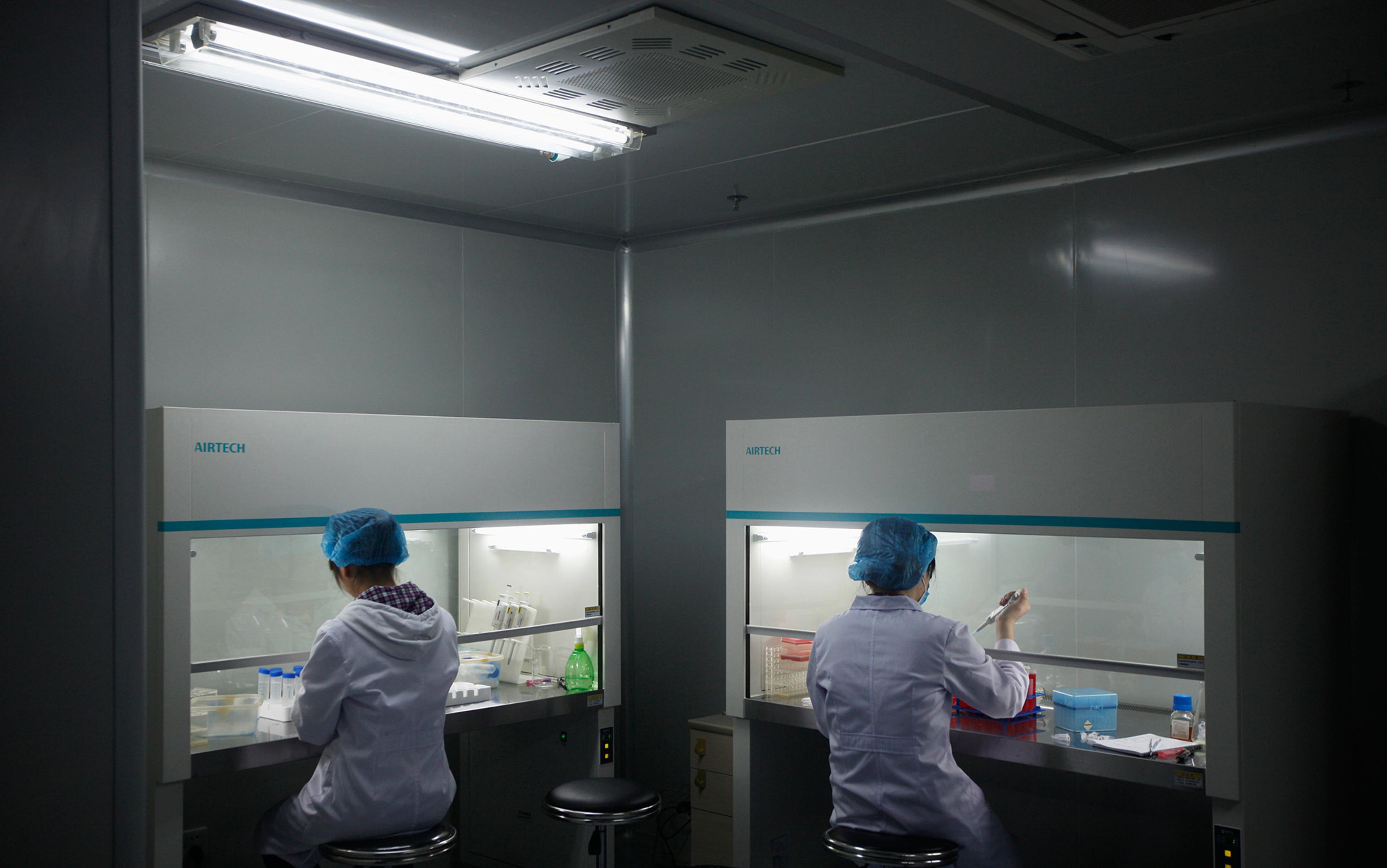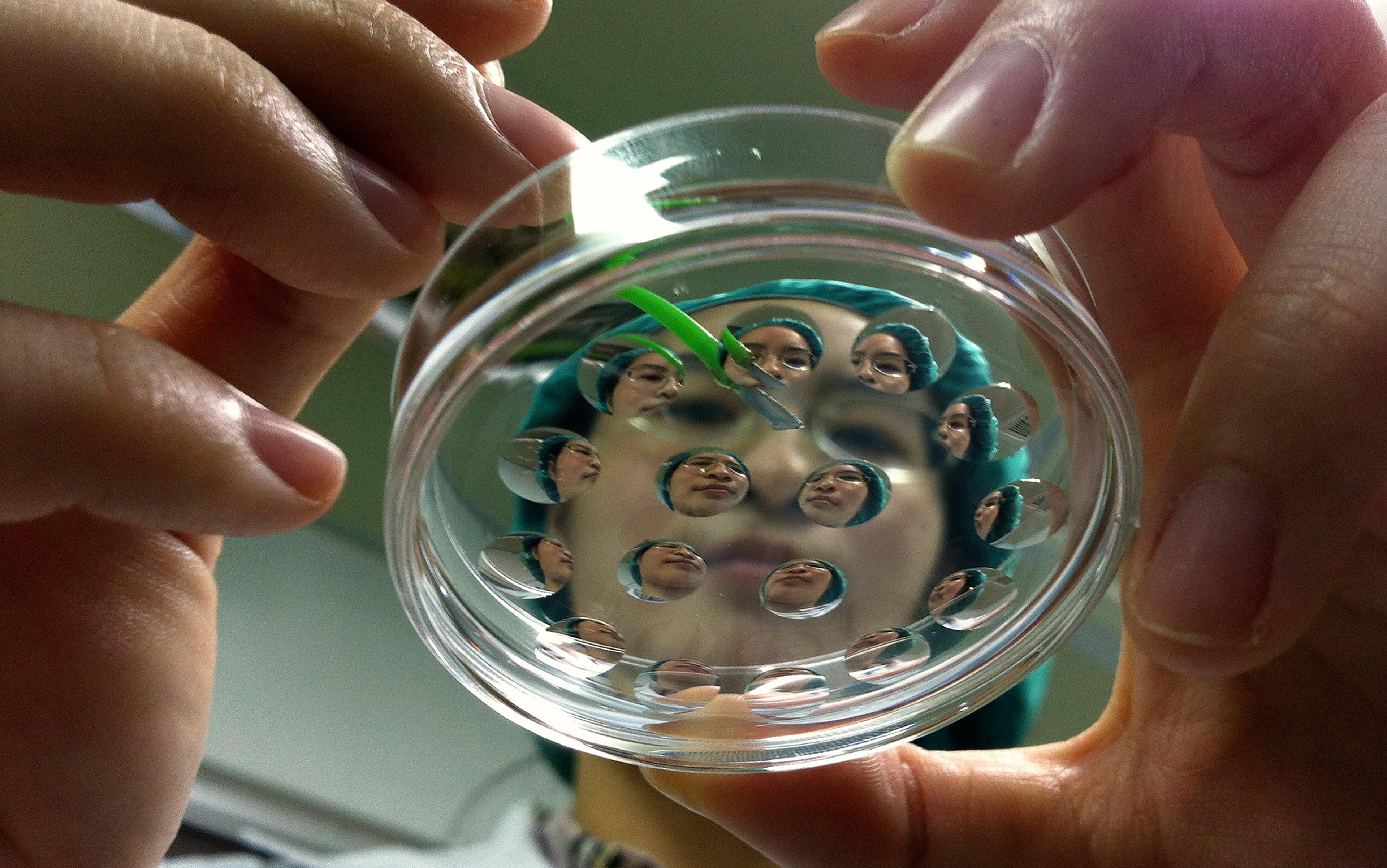DNA is a metaphor for our age. It conveys the powerful idea that our identity is scientifically reducible to an unambiguous, determinative code. We hear this idea expressed all the time. The car company Bentley advertises for employees saying: ‘Hard work is in our DNA.’ The footballer David Beckham says: ‘Football is in England’s DNA.’ And a toll-collector for the Golden Gate Bridge in San Francisco says: ‘Our DNA is embedded in this bridge.’
Everyone knows these statements aren’t literally true, but although we might understand their figurative meaning, they continue to reflect, and influence, how we think. Even biologists, being quite human, too often think metaphorically and assign properties to genes that genes don’t have. The metaphor works because our society has a deeply embedded belief in genes as clearly identifiable material things which explain our individual natures, making them inherent from the moment of our conception and thus predictable. If hydrogen and oxygen are the causal atoms of water, genes are the causal atoms of our existence.
And we’re surrounded. News stories appear every week announcing the discovery of a gene ‘for’ this trait or that. Direct-to-consumer (DTC) genetic testing and ancestry determination companies are thriving, because consumers believe their genes will tell them more about their ancestry than family stories can. They also want to know whether they are fated to suffer from particular diseases, and they believe that this too is written in their genes. Sperm banks suggest that prospective parents consider a potential donor’s hobbies, the languages he speaks, his favorite foods, or his educational attainment, as though these traits are written in his sperm.
But try or wish as we might, the idea that everything about us is reducible to genes is not supported by real-world observations. Indeed, a simplistic picture of genes as individual causal things with straightforward effects is out of date in many ways. For starters, we now know that no gene acts alone. Complex traits — such as the diseases that most of us will eventually get — result from the interactions among multiple genes and/or environmental factors. Predicting disease depends not just on identifying our genotype, the particular, unique set of DNA sequence variants we inherited, but also on predicting our future environments — what we’ll eat, drink, or breathe, the medications we’ll take, and so on — which neither DTC companies nor anyone else, no matter how ‘expert’, can do.
Because environments vary and every genome is unique, multiple studies of a given trait or disease will generally yield different results. DTC estimates of disease risk are inherently probabilistic, not fixed. The same applies to choosing a sperm donor based on behavioural traits — of which any genetic component would likely be swamped by cultural and environmental factors, such as the food the donor was exposed to when growing up, or whether he could afford to go to university.
The metaphor that corporations and nations have their own DNA, and the belief that genes have straightforwardly determinative effects, might provide a comfortable, tempting image of simple cause and effect. But it’s akin to replacing the religious concept of ‘soul’ with the modern, scientific one of ‘gene’, and that’s very misleading. It tends to assign a kind of fixed metaphysical essence, analogous to Calvinism’s predestination, and drastically simplifies what are actually complex phenomena (dogmatic beliefs are like that). And there are consequences.
Genes are certainly real, so it’s important to understand what they can tell us about ourselves. You might be told that, based on your genotype, you have a (let’s say) 15 per cent chance of heart disease. This is a risk, or probability, not a certainty, nor anything like it. Probabilities are not the same as ‘causes’, and they can be extremely difficult to grasp. For example, even in the simplest situation, such as when we flip a coin to see who pays for the drinks, we might say our thumb is the cause of the flip itself, but we tend to think of the actual result — the ‘heads’ or ‘tails’ — as down to ‘chance’.
But what do we mean by chance? It is easy to wrap our heads around ideas such as coin-flipping by assuming that every flip has a 50-50 chance of a heads or tails result. Sounds simple enough, but what if we need to predict the specific outcome of a large number of such flips, somewhat like the challenge we face in predicting, from a person’s genotype, the risk of life events such as a heart attack or diabetes? Each of us has a unique set of variants in perhaps hundreds of different genes that separately contribute to the probability of disease. What will each one do? Will they flip as ‘illness’ or ‘health’? Is that even a realistic question?
Unlike coin-flipping, disease prediction depends on knowing, assuming or guessing the underlying risk associated with each individual genetic variant, risks that differ from gene to gene, and that do not work like the simple heads and tails of a coin (which, if the coin is fair, will always carry the same risk). What kinds of ‘probabilities’ are they when it comes to understanding what can be predicted from an individual’s genes and the major life decisions that might follow? Just as a coin heavily biased towards heads can come up tails on a given flip, a person inheriting a genotype that raises the risk of diabetes might not in fact get the disease. And risks can easily be perceived as more serious than they actually are, even if we assume the risk estimate is solid. If the risk of a given disease is, say, 2 per cent in the general population, and our best guess is that your genotype raises that by a whopping 25 per cent, that still only changes your actual risk to 2.5 per cent.
Genes must be contributing to risk in important ways. But if so, how can they be as slippery as eels when we try to find them?
So far, we’ve considered purely physical traits. What role do genes play in non-physical traits such as behavior, or even the ultimate questions of consciousness and free will? Here, the metaphoric replacement of ‘soul’ by ‘gene’ works in a different way. How much of our feelings, thoughts and behavior is actually determined from the moment we are conceived, and could in principle be read like a computer program from our genome?
The extent to which we have free will is a fundamental aspect of how we view our ‘selves’, and for many religions, relates to whether we can be held responsible for our moral behavior. The scientific view, on the other hand, goes something like this: we live in a totally material world made of matter, energy, and the forces that connect them. Since genes are the fundamental causal elements of life, it would seem inevitable that, if we knew enough, we could predict everything about all of us — our health, our behavior, and our ideas. The alternative would seem to be mysticism — invoking some sort of immaterial something-or-other that we can’t measure but that affects who and what we are. But if genetic prediction is so unreliable and complex, how did our view of ourselves get so entangled in genetic determinism in the first place, and what might all this tell us about not just physical traits, but such elusive ideas as free will?
Today’s gene metaphor is a fabric woven of two threads from the 19th century. In 1858, Alfred Russel Wallace and Charles Darwin proposed a stunning new framework for understanding life in a way that was entirely materialistic and freed from mysticism. The diversity of life, they said, is due to the historical process of evolutionary divergence from common ancestry, in which present-day traits and functions are an outcome of natural selection. Darwin and Wallace developed their theory in the Newtonian era, when the aspiration of science was to understand existence in terms of ‘laws of nature’. Darwin viewed natural selection as, like gravity, a ubiquitous, essentially deterministic causal force in a relentlessly competitive world, a view he expressed in the foundation text of evolutionary biology, On the Origin of Species (1859).
Evolutionary determinism was the first thread of the gene metaphor. Natural selection preserves only what is inherited from the successful organisms in the past. The second thread comes from Darwin’s contemporary, Gregor Mendel, who conducted his studies of peas in order to understand the nature of inheritance. His findings also fit the Newtonian worldview perfectly. If natural selection was a law of nature, like gravity, then Mendel’s laws of inheritance promised to identify the fundamental building blocks of biological causation. By choosing specific traits that he knew bred true, Mendel identified a pattern of inheritance that provided perhaps the most powerful tool for research design in the history of science. The genetic research that followed eventually led to the identification of the nature of DNA, the locations and structure of genes in DNA, and the understanding of how they code for proteins. But that same Mendelian thinking made us conceptual prisoners of the deterministic, law-like interpretation of genetic function that leads us to think of traits themselves, not just genes, as discretely packaged units, produced by discretely packaged genes. That suggests that a pea seed already contains mini-green peas, or that a fertilised human egg contains a tiny human: a kind of genetic superstition.
Mendel showed that inheritance was probabilistic in the same sense as coin-flipping. Each parent carries two copies of every gene, and they each transmit, at random, one of those copies to each of their offspring. But once the particular randomly transmitted copies are inherited, their effects in the offspring follow causally deterministic principles: the resulting peas were either green or yellow, wrinkled or smooth.
There are plenty of instances in which genes do seem to be determinative, and work as they did for Mendel’s peas. Hundreds of known diseases, for example, appear to be caused by one or just a few genetic changes that disrupt or destroy a gene in some major way. Examples include cystic fibrosis, muscular dystrophy, and diseases of the nervous system such as Rett syndrome or Tay-Sachs disease. But as a rule, these ‘Mendelian’ diseases are a minority of rare traits that appear early in life, regardless of lifestyle exposures. The success for medical genetics in picking this easy-to-find ‘low-hanging fruit’ hasn’t given us a way to harvest the rest.
This isn’t for want of trying. Billions of dollars have been spent on searching for ‘the’ genes ‘for’ such common diseases as obesity, heart disease, type 2 diabetes, stroke, hypertension, cancers, asthma, and countless other afflictions. There have been few notable successes. The frustration is great because for most traits, including most diseases, members of an affected person’s family tend to have increased risk of the same trait or disease, in ways that can’t entirely be blamed on shared environment. This strongly reinforces the DNA metaphor by suggesting that genes must be contributing to risk in important ways. But if so, how can they be as slippery as eels when we try to find them? The reason is that the fabric of genetic causation is probabilistic both in terms of the inheritance of genes, and their effects.
The standard ‘scientific method’ we were all taught in school was based on stating, and then testing, a specific hypothesis about what causes some outcome; for example, that mutations in the LDL receptor gene (which affects cholesterol levels) can cause heart disease. However, most studies of such specific hypotheses have come up empty. The growing availability of wholesale DNA sequencing technology, largely initiated by the completion of the human genome project in 2003, led to the widespread abandonment of standard hypothesis-based genetics, to be replaced by what is called ‘hypothesis-free’ genomics.
In keeping with the DNA metaphor, the idea of the genomic approach is to assume that genes simply must be causing a trait of interest, and to look across the entire genome to find variants that are more common in individuals with the trait than in those without it. The hope was that we would soon eliminate the debilitating or fatal diseases to which most of us now fall victim, once we had exhaustive knowledge of genome-wide variation.
Genomic studies searching for causal genes have grown ever larger and more expensive, but commensurately important results have yet to roll in. Most of the estimated overall genetic influence on the traits or diseases of interest is still unidentified. What we’re finding instead is ‘polygenic’ causation, that is, that many different parts of the genome contribute mainly trivial individual effects.
Each genetic variant is a very weak ‘coin flip’ with unstable probabilities, and everyone is flipping a different set of coins
A typical well-studied example is Crohn’s disease, an inflammatory bowel disease that runs in families, and thus would seem to have a major genetic component. However, the most recent study, by Heather Elding and colleagues at University College London, published in The American Journal of Human Genetics, estimates that the number of genes associated with the disease is around 200, most with very small effects, which explains only a small amount of the genetic background of this disease. To liken this again to coin-flipping, variants at each ‘causal’ gene affect risk in some probabilistic way, usually very small — far from 50-50 — and with no guarantee whatever that the same variant provides the same risk in different people who carry it, or in different populations, or in men or women, or at different ages. It’s as though each coin keeps changing its probability of coming up heads. Thus, the predictive power of this type of ‘personalised genomic medicine’ is generally very weak, like trying to predict the outcome of hundreds of individual-specific coin-flips. That’s why, with some fortunate exceptions, the clinical or therapeutic value of all these genetic studies has so far been slight.
It’s a similar story for normal traits as it is for disease. Height is an easily measured trait that clearly runs in families, and many studies have been done looking for genes for this trait. More than 400 contributing genetic regions, from an estimated 700 or so, have been found but, again, none with very large effects. In fact, to date, only 10 per cent or so of the variation in height has been explained, as a study from Exeter University published in Nature in October 2010 demonstrated. Many more genes will be found to contribute, but environmental factors such as diet or illness will as well.
Height and Crohn’s disease are just two of many instances of this same basic pattern. Behavioral and psychiatric traits are proving to be just as intractable, and the story is similar with the same kinds of studies in other species, as varied as yeast, insects, and plants. What is being documented is the blunt reality of the state of nature. No matter how unwelcome it might be for those who still hope for simple deterministic-like genetic causation, complex traits are affected (one should perhaps no longer say ‘caused’) by multiple genes with individually small and typically fickle effects. In addition, nobody disputes that there is usually a hefty, indeed often predominant, environmental component to the risk of disease, although it’s typically not very seriously considered by geneticists. These environmental factors are themselves quite complex and elusive to assess, or even identify.
Perhaps the most important single fact lurking in all of this is that when numerous genes contribute to a trait, the specific set of contributing variants is different for every individual. This is a many-to-many causal relationship: there are many genetic paths to a single height, blood pressure, triglyceride, or cholesterol level. Equally, a given genotype is consistent with many different trait values. Each genetic variant is a very weak ‘coin flip’ with unstable probabilities, and everyone is flipping a different set of coins. So, even if we identify the genotype of an individual, we can’t as a rule accurately predict its effects, even though this is just what ‘personalised genomic medicine’ has promised to do.
This makes another aspect of the DNA metaphor problematic. Instead of the widespread view of life as raw, relentless Darwinian competition leading to a single ‘fittest’ way to be, a far better way to see it is in terms of cooperation. By cooperation we do not necessarily mean the social, emotional variety. Cooperation describes the way in which a trait is produced by many factors, the countless genes and lifestyle aspects that contribute to the trait. If these factors do not work adequately together, the trait will not successfully be built into an embryo in the first place. Extensive webs of cooperation within us — genes with genes, organelles with organelles, cells with cells, tissues with tissues, and so on — mean that except for the rare disastrous instances, individual contributing genes neither spell doom nor success on their own. If there are many ways to fail — as the rare, serious genetic mutations show — there are a great many more ways to succeed.
Another way to view cooperation among genes is that evolution has provided a kind of redundancy that protects individuals from harmful mutations and overly harsh screening by natural selection. If each gene is, in itself, not a deterministic cause of some useful trait, then the organism can often do just fine with modification of or even loss of that gene, because other contributing genes cover for it, or any one modification has only a trivial effect. We know, for example, that many well-known variants that are clearly associated with very serious human disease are the normal state in other species. Indeed, whole-genome sequence studies have consistently shown that all of us carry a significant number of defunct or seriously disrupted genes, and this can include genes whose mutations are clearly implicated in some disease contexts, even if we ourselves are healthy.
All this might seem confusing: genes are molecules and hence fundamental causal agents of life, yet their effects are highly probabilistic and very hard to pin down or predict. As we have tried to explain, although genetics and evolutionary research are often very technical, the issues are actually reasonably simple. That’s fortunate, because an understanding of how life and evolution work as an orderly collection of uncertainties can lead us to a better sense of what is ‘inherent’ in our nature, and why.
In this light, we can return to the intriguing topic of behavior and, particularly, of free will. What we know about life undermines the explanatory power of molecular reductionism: that is, the attempt to use genetic variants to predict not only physical traits but also higher-level phenomena – such as the ability to do calculus, or write poetry – which seem to ‘emerge’ magically out of nowhere. For scientists attempting to understand life’s complexity, this might be the winter of our discontent, but Richard III’s soliloquy was written in Shakespeare’s hand — not his genome.
Complex organisation arises from webs of interaction among causal factors. Even if individual factors cannot be held responsible for particular developments, complex phenomena such as people, skills, skulls, languages, and even football teams clearly do exist, and have a material rather than any mystical or immaterial basis. In fact, emergent complexity takes essentially the same form, and presents the same challenge, in the very different contexts of biology, ecology, anthropology, sport — and free will.
But here’s the conundrum we mentioned earlier: if science says that the world is an entirely material phenomenon following universal laws of causation, then even the idea that we are responsible for our thoughts and actions comes under siege. Personality? Intelligence? Criminality? Political preference? You name it — even our moral decisions must, in principle, be predictable from our inherent, inherited genome. Yet, our thoughts and actions seem to be even farther beyond the reach of gene-based prediction than physical traits such as diabetes or height, which we’ve seen to be extremely complex in their causation. Is this just a temporary limit in scientific knowledge, or is something more profound going on here?
Perhaps as we are evolved biological organisms, uncertainty is unsettling to us
The question is more than incidental, because it raises the rigid idea of a mind/body dualism. Dualism asserts that mind and consciousness, whatever they are, are free from the usual material constraints. In other words, we have free will, just since we feel that we do. Free will is at the heart of assumptions that we are morally responsible for our actions, which in turn affects social and legal policy as well as religious notions of earned salvation. Clearly, if individuals are just the product of their genes, then they can’t be held responsible. Yet, how can they not be the product of their genes?
An answer might lie in the understanding of complex causation that we have presented here. We aren’t qualified to deal with religious issues about moral responsibility, but from a scientific point of view there is no mind/body dualism. Mind, wondrous though it might be, is in fact the product of molecular forces, including genes. Yet the mind seems fundamentally unpredictable from genes. The reason is that the brain and its activities are the result of countless billions, if not trillions (or more) of ordinary molecular and cellular interactions of all sorts, each of them probabilistic, from gene usage to the formation of neural connections, beginning before birth and extending over our lifetime’s experiences. During development, our brains are programmed to ‘wire’ up in a very general way, but the details in each individual are the result of experience, and our individual behaviours are the result of our brains responding to our unique set of experiences.
We should not be at all surprised that, just like most other traits, behaviour is not specifically predictable from genes. The massive web of probabilism makes such prediction weak at best, just as we’ve seen for physical traits. Our mental activities feel as if they are free, and their unpredictability supports that feeling. But the reason is that the causation involved is so complex and deeply probabilistic that it is, in effect, unpredictable even if we were to try to enumerate all the contributing factors. In that sense, for all practical purposes, we are indeed free.
It is sobering to point out that none of these issues about determinism, probability, complex causation — and even their implications for free will — are new. They can be traced back to the classical philosophers, and were vigorously debated along with the development of probability and statistics in the 18th through to the 19th centuries, and then reinforced by discoveries in sub-atomic physics in the 20th century. The significance and challenge of probabilistic multifactorial causation have been recognised. What is new is that we have a much better documentation of this problem from a genetic point of view. But, conceptually, we have not advanced very much in our understanding of what are deeply puzzling aspects of the way the cosmos — including life — works.
Human beings don’t like things that are unexplained. We want the comfort and sense of safety that comes from predictability. Perhaps as we are evolved biological organisms, uncertainty is unsettling to us. And, in the scientific era, we assume a material understanding of causation. That’s what the idea of determinism represents in a simple, easy-to-grasp way. We want to be in control, to be able to manipulate nature to alleviate the problems that we face in a finite life in a finite world. We want our causes to be simple, real causes, and that is perhaps why the metaphor of the gene as the atom of causation in life is so easy to absorb, and its subtleties so easy to overlook. We are made very uneasy by things that are only probabilistic unless, as in coin-flipping, we can sense what’s going on. When we can’t see it, and causation is many-to-many, that is far too much for our minds to deal with easily. Yet that seems to be the reality of the world.






